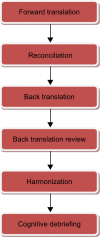Factor structure of the Persian version of general, social, and negative self-consciousness of appearance domains of Derriford Appearance Scale 59: an application in the field of burn injuries
- PMID: 28144145
- PMCID: PMC5248938
- DOI: 10.2147/NDT.S121250
Factor structure of the Persian version of general, social, and negative self-consciousness of appearance domains of Derriford Appearance Scale 59: an application in the field of burn injuries
Abstract
Background: The Derriford Appearance Scale 59 (DAS59) is a widely used measure of the spectrum of psychological distress and dysfunction that is characteristic of disfigurement. Also, disfigurement due to burn injury leads to feeling guilty or less socially competent, avoiding social situations, suicide, poor self-esteem, sexual difficulties, and depression. Therefore, the purpose of this study was to translate and culturally adapt three subscales of DAS59 into Persian language and to investigate its factor structure for Iranian burned patients.
Method: Translation-back translation of the scale into Persian was done. The internal consistency of the translated scale was evaluated by Cronbach's alpha. Next, construct validity of the translated instrument was assessed by exploratory factor analysis using principal components and rotation of varimax methods. This research involved a convenience sample of 189 adult burned patients with disfigurement in their face, head, ears, neck, hands, and legs.
Result: The Cronbach's alpha for overall scale, subscales 1, 2, and 3 were 0.93, 0.93, 0.89, and 0.80, respectively. The best solution from the principal components analysis of the 40 items of the DAS59 revealed three factors corresponding to the three subscales with 20 items: factor 1 (general self-consciousness of appearance) consisted of 9 statements accounting for 33.23% of the variance (eigenvalue =9.23); factor 2 (social self-consciousness of appearance) consisted of 7 statements accounting for 22.91% of the variance (eigenvalue =1.53); and factor 3 (negative self-concept) consisted of 4 statements accounting for 14.98% of the variance (eigenvalue =1.13).
Conclusion: The factor structure of the three subscales of DAS59 provides a widely acceptable, psychometrically robust, factorial self-report scale to assess distress and dysfunction in problems of appearance among Iranian burned patients, and facilitates further research into the efficacy of treatment approaches for problems of appearance and early investigation of therapeutic outcome.
Keywords: Derriford (DAS59); appearance; burns; disfigurement; psychological scale; validity.
Conflict of interest statement
The authors report no conflicts of interest in this work.
Similar articles
-
Reliability and Validity Testing of the Persian Version of the Derriford Appearance Scale 24 in a Sample of Individuals with Craniofacial Irregularity and Amputation.Can Prosthet Orthot J. 2023 Nov 24;6(1):41454. doi: 10.33137/cpoj.v6i1.41454. eCollection 2023. Can Prosthet Orthot J. 2023. PMID: 38873006 Free PMC article. Review.
-
The DAS24: a short form of the Derriford Appearance Scale DAS59 to measure individual responses to living with problems of appearance.Br J Health Psychol. 2005 May;10(Pt 2):285-98. doi: 10.1348/135910705X27613. Br J Health Psychol. 2005. PMID: 15969855
-
How to assess appearance distress and motivation in plastic surgery candidates: Italian validation of Derriford Appearance Scale 59 (DAS 59).Eur Rev Med Pharmacol Sci. 2016 Sep;20(18):3732-3737. Eur Rev Med Pharmacol Sci. 2016. PMID: 27735048
-
Self-Consciousness of Appearance in Chinese Patients With Cleft Lip: Validation of the Chinese Derriford Appearance Scale 59 (DAS 59) Instrument.Front Pediatr. 2022 Feb 9;9:825997. doi: 10.3389/fped.2021.825997. eCollection 2021. Front Pediatr. 2022. PMID: 35223716 Free PMC article.
-
The Derriford Appearance Scale (DAS59): a new psychometric scale for the evaluation of patients with disfigurements and aesthetic problems of appearance.Br J Plast Surg. 2001 Apr;54(3):216-22. doi: 10.1054/bjps.2001.3559. Br J Plast Surg. 2001. PMID: 11254413
Cited by
-
Reliability and Validity Testing of the Persian Version of the Derriford Appearance Scale 24 in a Sample of Individuals with Craniofacial Irregularity and Amputation.Can Prosthet Orthot J. 2023 Nov 24;6(1):41454. doi: 10.33137/cpoj.v6i1.41454. eCollection 2023. Can Prosthet Orthot J. 2023. PMID: 38873006 Free PMC article. Review.
References
-
- Soni CV, Barker JH, Pushpakumar SB, et al. Psychosocial considerations in facial transplantation. Burns. 2010;36(7):959–964. - PubMed
-
- Moss TP. The relationships between objective and subjective ratings of disfigurement severity, and psychological adjustment. Body Image. 2005;2(2):151–159. - PubMed
-
- Thompson A, Kent G. Adjusting to disfigurement: processes involved in dealing with being visibly different. Clin Psychol Rev. 2001;21(5):663–682. - PubMed
-
- Partridge J. Psycho-social reflections on craniofacial morphogenesis. Semin Cell Dev Biol. 2010;21(3):333–338. - PubMed
-
- Cash TF, Santos MT, Williams EF. Coping with body-image threats and challenges: validation of the body image coping strategies inventory. J Psychosom Res. 2005;58(2):190–199. - PubMed
LinkOut - more resources
Full Text Sources
Other Literature Sources


